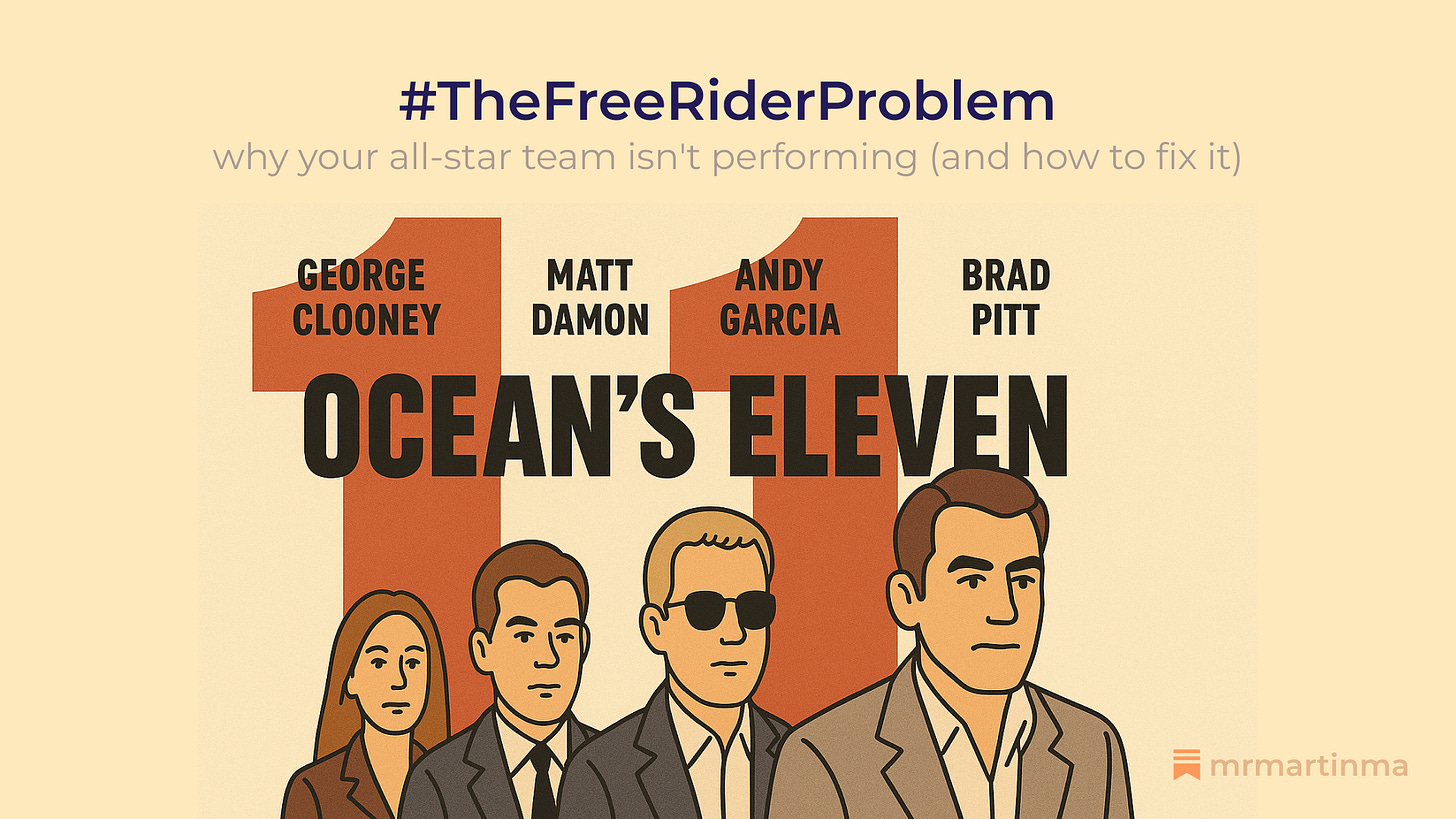Why Your All-Star Team Isn't Performing (And How to Fix It)
You hired a team of all-stars. So why does it feel like you're the only one pulling the weight?
It's a common frustration for leaders, and it reminds me of the central problem in the movie Ocean's Eleven. Danny Ocean assembles a crew of the best specialists in the world to rob three Las Vegas casinos. The prize is $160 million. If they succeed, everyone gets rich.
But here’s the real question: Why would any single member of that crew take the biggest risk? The logical, self-interested move for any one member is to let the others do the dangerous work and still get a cut.
This is the Free-Rider Problem in a tuxedo. It’s the silent killer of our most ambitious goals. And it’s why economist Mancur Olson’s decades-old theory is more relevant than ever.
The Flaw in the Plan: The Logic of the Heist
Mancur Olson’s core insight in The Logic of Collective Action is a brutal truth:
just because a group of rational people share a common goal, it doesn’t mean they will automatically work together to achieve it.
This is the brilliant but disengaged engineer who lets the rest of the team handle the tedious bug-fixing. It's the marketing department that doesn't fully commit to the new product launch, assuming sales will carry the weight.
Here's my read on this, from coaching teams through these exact situations:
Not Bad Actors - These people are rarely 'bad actors' making a conscious choice to slack off.
Subconscious Calculation - More often, their 'rational calculation' is subconscious—a natural human response to a flawed system.
Brains Conserve Energy - When individual contributions feel invisible, or when the link between personal effort and the final outcome is unclear, our brains are wired to conserve energy.
Adapting to Structure - It's not malice; it's a feature of organizational physics. They often don't even realize they're free-riding; they're simply adapting to the structure they're in.
So if that's the problem, how do you fix it? This is where the leader becomes the mastermind. To solve the free-rider problem, you have to architect a better game.
The Mastermind: The Leader as Architect
The key to mobilizing a team of all-stars, according to Olson, is Selective Incentives—private rewards or punishments that apply only to those who contribute. Danny Ocean isn't just a smooth talker; he's a master architect of these incentives.
1. Structural Incentives (The Perfect Role)
The plan is a complex machine where every single part is critical. There is zero role overlap. Contribution isn't just encouraged; it's structurally required.
Leader's Takeaway: Stop assigning tasks; start designing indispensable roles. Make each person the sole owner of a critical piece of the puzzle.
2. Coercive Incentives (The Interlocking Stakes)
The plan is so interconnected that one person's failure guarantees everyone's failure. This creates immense peer pressure that makes loafing a betrayal of the entire group.
Leader's Takeaway: Create shared accountability. Structure projects so team members are mutually dependent on each other's success.
3. Solidary Incentives (The Elite Club)
The reward is more than cash. It's the reputational glory of being part of the most audacious heist in history.
Leader's Takeaway: Money is a motivator, but status, mastery, and belonging are often more powerful. Create opportunities for your team to do career-defining work.
The Inside Job: The Human Element of Trust and Purpose
Here’s where it gets really interesting, because Olson's purely rational model doesn't account for everything. The Ocean's Eleven plan works because of two factors that transcend economics:
1. The "Rusty Ryan" Factor (Trust)
Rusty joins because he trusts Danny. The rest of the crew joins because they trust Rusty. This pre-existing network of trust acts as a powerful social glue. Your ability to execute a brilliant plan is directly proportional to the level of trust you've built before the project even begins.
2. The "Reuben Tishkoff" Factor (Purpose)
Reuben doesn't need the money. He joins for a purposive incentive: revenge against his rival. For some of your best people, the "why" behind the work will always be a more powerful driver than any material reward.
What You Should Copy: Assembling Your Crew
The difference between a team that succeeds and a group of talented individuals who fail is leadership. It’s about being the architect of a system that makes full commitment the only rational choice.
Be the Architect, Not Just the Visionary: Don't just present the goal. Design the system where every role is indispensable. (btw, this is why OKR works, because you will need to ground the objective with key results as an architect)
Make Interdependence Your Ally: Structure work so that success is impossible without total team collaboration.
Offer More Than Money: Combine material rewards with the powerful incentives of status, mastery, and a compelling mission.
Invest in Trust and Purpose: The most brilliant plans fail without them. Build your reputational capital every single day.
Ultimately, the free-rider problem is rarely a problem with your people; it's a problem with the system you've designed. Stop trying to motivate your team and start architecting a game they can't help but win. That's how you move from managing a group of all-stars to leading an unbeatable crew.
So, my question to you is this:
Think about the best team you've ever been on. What was the "selective incentive"—the unique role, the shared stakes, or the powerful mission—that made everyone fully committed?
I’d love to hear your stories.
#Leadership #Management #TeamCulture #Strategy #Productivity #FreeRiderProblem


